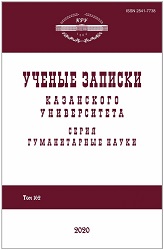Зарождение и развитие средневековой нарративной традиции описания «Чёрной смерти»
Origin and Development of the Medieval Narrative Tradition of “Black Death” Description
Author(s): Timur Faritovich KhaydarovSubject(s): Social history, Middle Ages, Health and medicine and law, Hermeneutics
Published by: Казанский (Приволжский) федеральный университет
Keywords: epidemics of antiquity; Bible; Ark of Covenant; Egyptian Executions; Thucydides; Hippocrates; Galen; Procopius of Caesarea; John VI Cantacuzene;
Summary/Abstract: The origin and development of ancient plots associated with mass epidemics, which formed the basis of the medieval narrative tradition of describing the Black Death – the second plague pandemic was analyzed. This aspect has been poorly studied in modern historiography. Special attention was paid tothe critical textual analysis of the published historical sources. The latter showed that the semantic series of the theme was formed when the complex of biblical texts was created in the Middle East. Furthermore, the views of ancient authors who adhered to the Greco-Roman narrative tradition played an important role for medieval authors, thereby determining a clear trend in medieval texts created by Byzantine chroniclers during the first and second plague pandemics (the plague of Justinian and the Black Death). When describing the causes of epidemics, medieval authors based their views on natural philosophical views of ancient authors (Hippocrates, Thucydides, and Galen). At the same time, the psychological state of medieval religious society stressed by the large-scale epidemic was described by Byzantine authors with the help of the popular biblical story “Egyptian Executions”. This duality in the description of epidemics persisted in Western Europe until the early 21st century.
Journal: Ученые записки Казанского университета. Серия Гуманитарные науки
- Issue Year: 162/2020
- Issue No: 1
- Page Range: 93-105
- Page Count: 13
- Language: Russian

